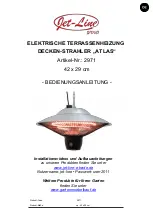
Form #43343530
Mar 09
-35-
SINGLE HEATER VENTING (VERTICAL THROUGH THE ROOF)
1.
When venting the heater to outside of building through a roof, use single-wall metal pipe. This is to be
constructed of galvanized sheet metal or other approved noncombustible corrosion-resistant material as
allowed by state or local codes.
2.
A vent passing through a combustible roof shall extend through an approved clearance roof thimble.
Double-wall, Type B vent must be used for the portion of the vent system which passes through the
combustible roof. An approved vent cap (Leslie “VersaCap”-Type B or equal) must be attached to end of the
flue.
3.
The maximum equivalent length of vent pipe should be carefully observed. A safety switch in the heater is
designed to shut the heater off before excessive flue restriction causes bad combustion. Refer to the Vent
Sizing Table for maximum vent lengths and vent pipe diameter.
4.
Joints between sections of piping shall be fastened by sheet metal screws or other approved means and
should be sealed to prevent leakage of flue gas into building. Aluminum or Teflon tape suitable for 550ºF
(3M Company tapes 433 or 363) or silicone sealant is recommended.
5.
All portions of the vent pipe shall be supported to prevent from sagging (6’ spacing is recommended).
6.
When the vent pipe passes through areas where the ambient temperature is likely to induce condensation
of the flue gases, the vent pipe should be insulated and a condensation drain should be provided.
7.
Minimum clearance for single-wall flue pipe to combustible material shall be 6 inches. This may be reduced
when the combustible material is protected as specified in the National Fuel Gas Code or the authority
having jurisdiction.
8.
Single-wall metal pipe shall not originate in any unoccupied attic or concealed space and shall not pass
through any attic, inside wall or concealed space, or through any floor. For the installation of a single-wall
metal pipe through an exterior combustible wall, refer to latest edition of the National Fuel Gas Code or the
authority having jurisdiction.
9.
A venting system shall terminate at least 3 ft. above any forced air inlet located within 10 ft.
Vent Cap (Leslie
VersaCap Type B)
Flashing
2 (5cm)
Clearance
Thimble
Seal Joint
and Annular
Space
10 ft (305cm)
or less
2 ft (77cm)
minimum
2 ft (77cm) minimum
(when no wall or
parapet exists)
4 Diameter
Vent
W
all or
Parapet
Flue Adapter
Collar
4 Vent Elbow
#10 Self-Drill
Screws
(typical)
4 Vent Pipe
(vertical position)
SINGLE HEATER VENTING (HORIZONTAL THROUGH SIDEWALL)
When venting the heater horizontally through a combustible outside sidewall, the same requirements listed
previously for venting Vertical Through The Roof apply except as follows:
1.
A vent passing through a combustible wall must pass through an approved clearance thimble (Air-Jet #4VT
or Ameri-Vent #4EWT or other thimbles) that are listed by a nationally recognized testing agency; double
wall Type B vent must be used for the portion of the vent system which passes through the combustible
sidewall.
2.
An approved vent cap (Breidert-Type L or equal) must be attached to the end of the vent pipe.
NOTE: To minimize problems associated with condensation in long horizontal runs, vent pipe can be insulated.
3.
Use the following correction factors to obtain the equivalent length when elbows are used:
•
Subtract 10 ft. for each elbow beyond 15 ft. from the heater.
•
Subtract 15 ft. for each elbow within 15 ft. of the heater.
4.
Limit to (2) 90º elbows in the vent system.
















































